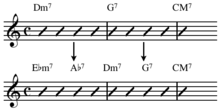Outside (jazz)
In jazz improvisation, outside playing describes approaches where one plays over a scale, mode or chord that is harmonically distant from the given chord. There are several common techniques to playing outside, that include side-stepping or side-slipping, superimposition of Coltrane changes,[1] and polytonality.[2]


The term outside is commonly used by jazz musicians playing in a post-bop idiom, but despite its frequent use in musicians’ jargon there is no set or standardized definition for it. As the term is commonly understood, outside is not a direct synonym to terms such as free improvisation, polytonality or atonality but a musical phenomenon in its own right. Also, outside concerns tonal tension; it does not involve breaking rhythmic, timbral or stylistic boundaries. Certain performance characteristics are as central in outside playing as they are in jazz improvisation in general: playing with good sound; with rhythmic drive and stability; and with confidence and conviction.
Side-slipping
The term side-slipping or side-stepping has been used to describe several similar yet distinct methods of playing outside. In one version, one plays only the five "'wrong'" non-
See also
Sources
- ^ Porter, Lewis. John Coltrane: His Life and Music. Ann Arbor: The University of Michigan Press. p. 225.
- ^ a b Vashlishan, M. THE ORIGINS OF DAVID LIEBMAN'S APPROACH TO JAZZ IMPROVISATION (PDF) (Thesis). William Paterson University. Retrieved 2014-01-27.
- ISBN 1-57623-875-X.
- ISBN 0-88284-722-8.
